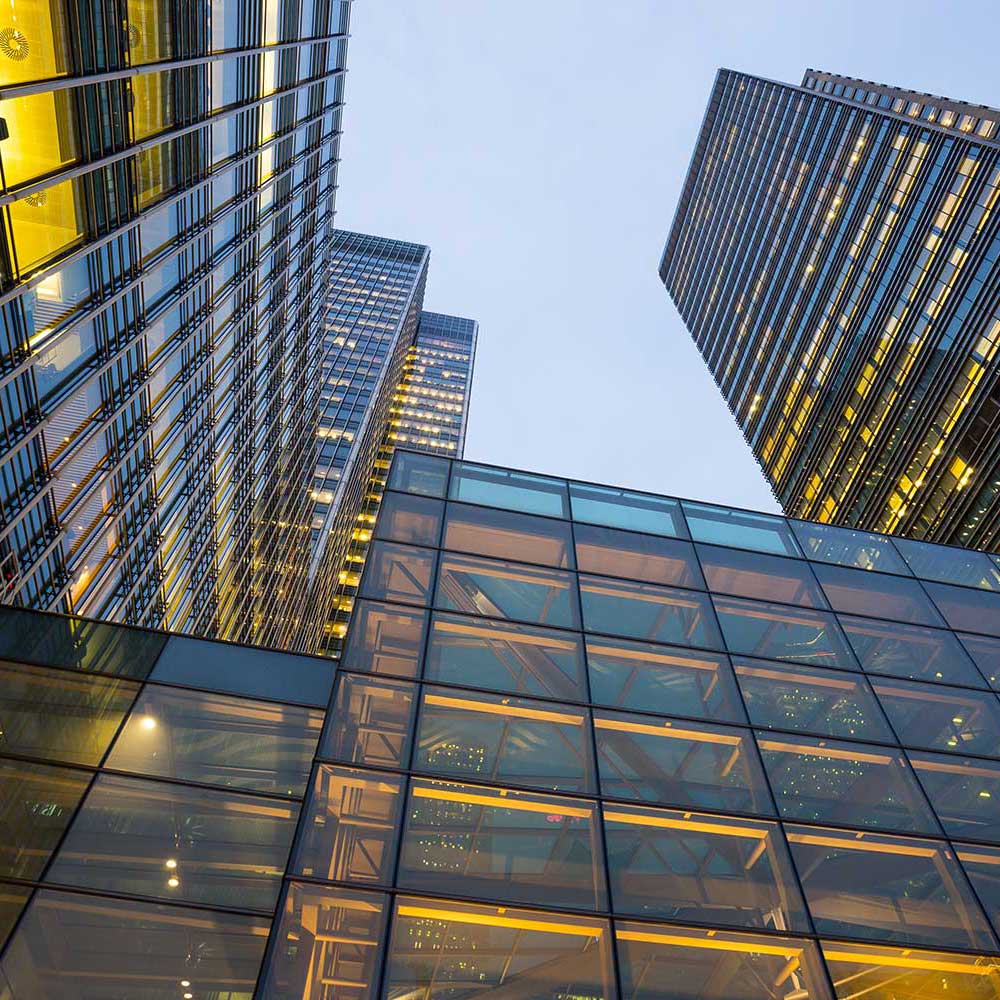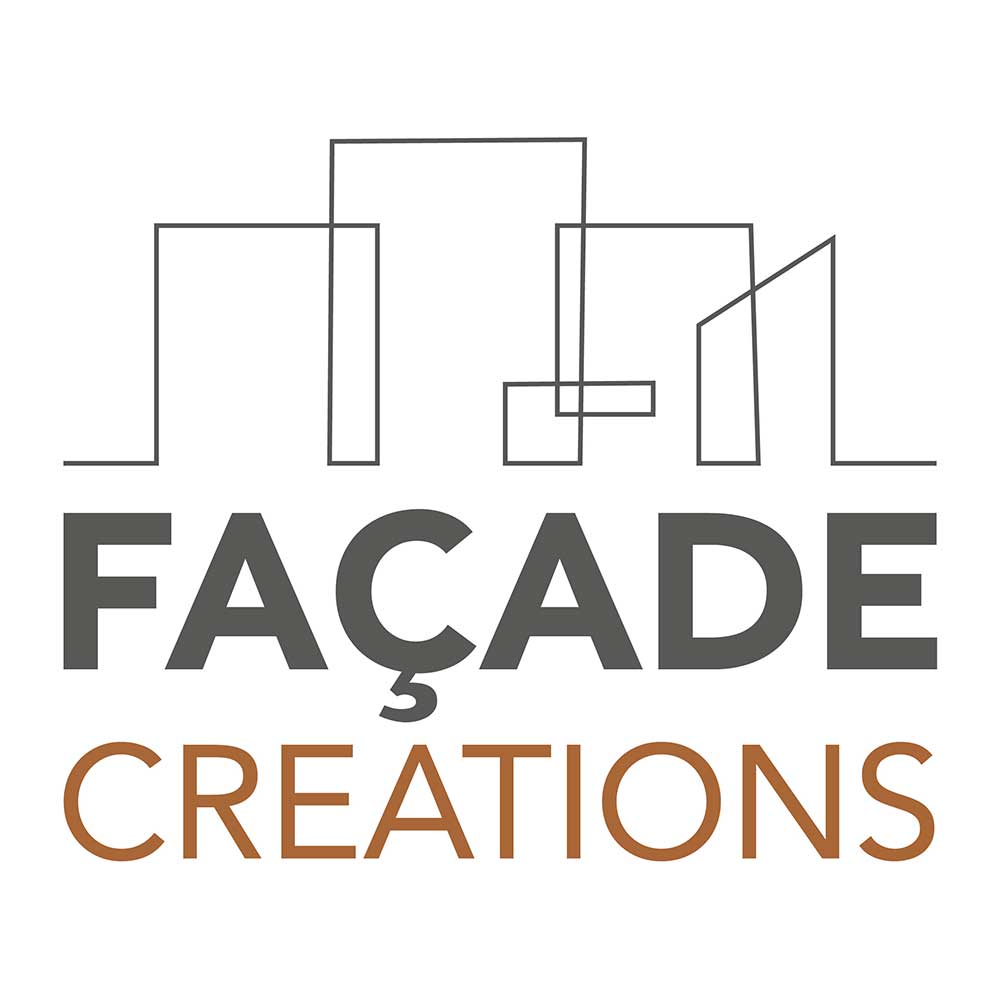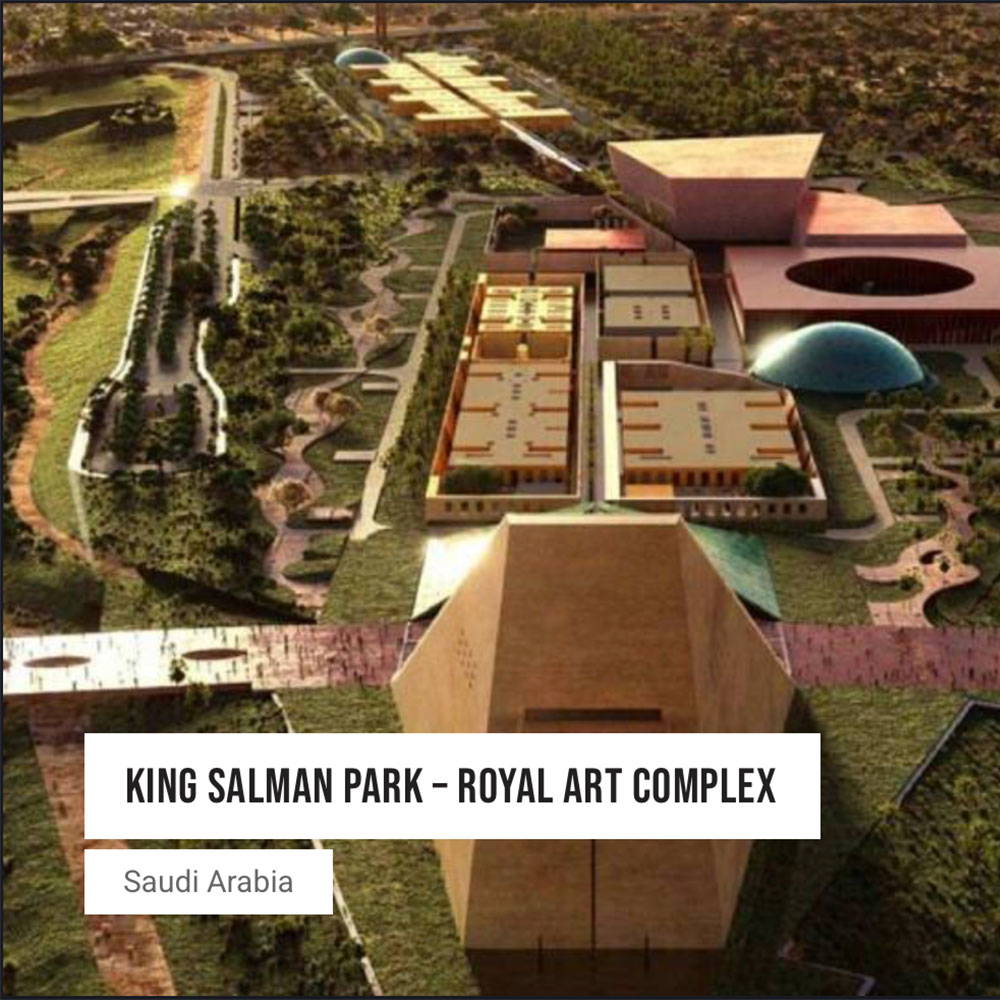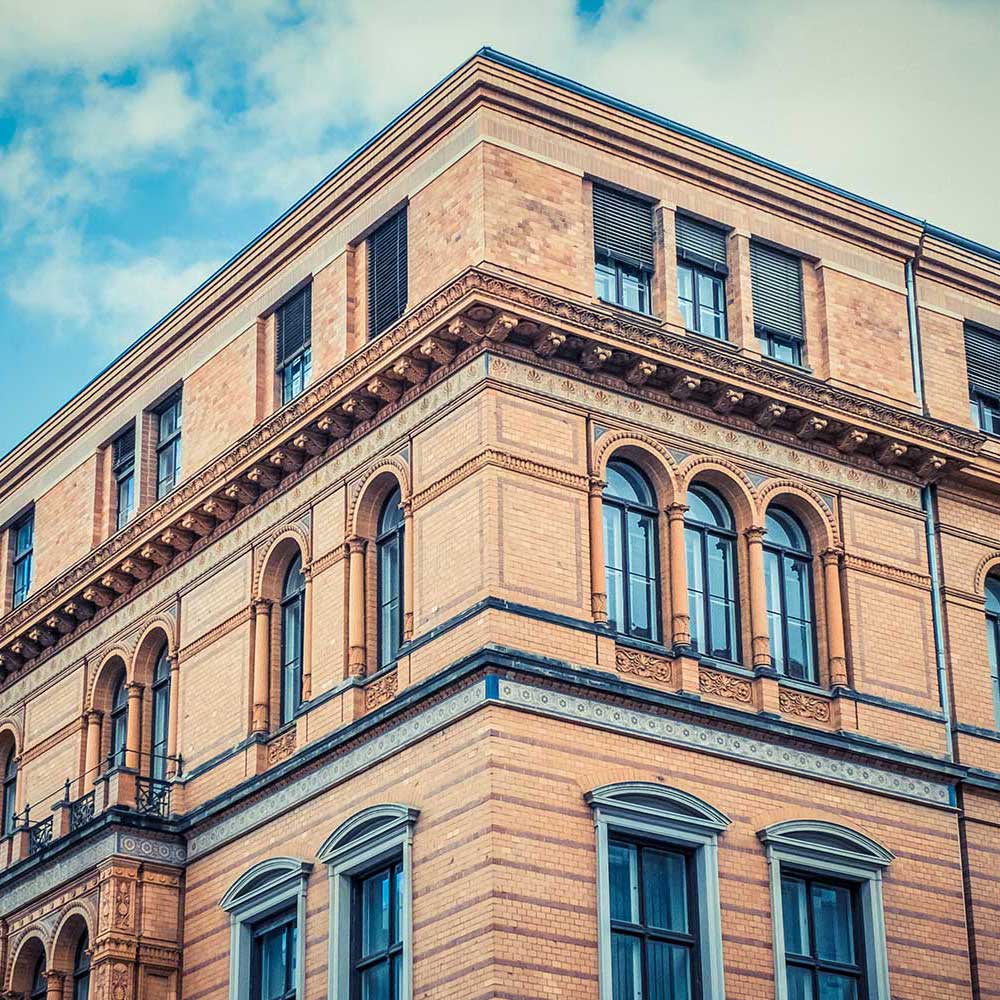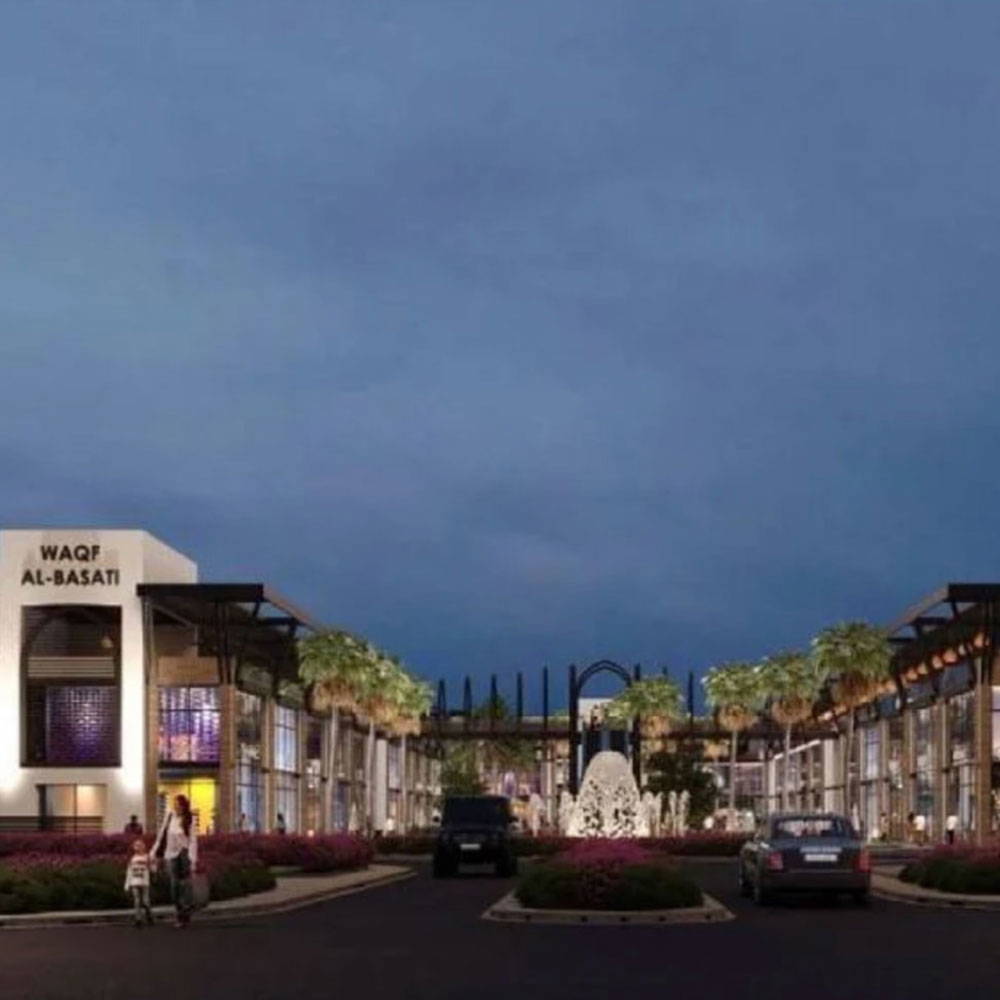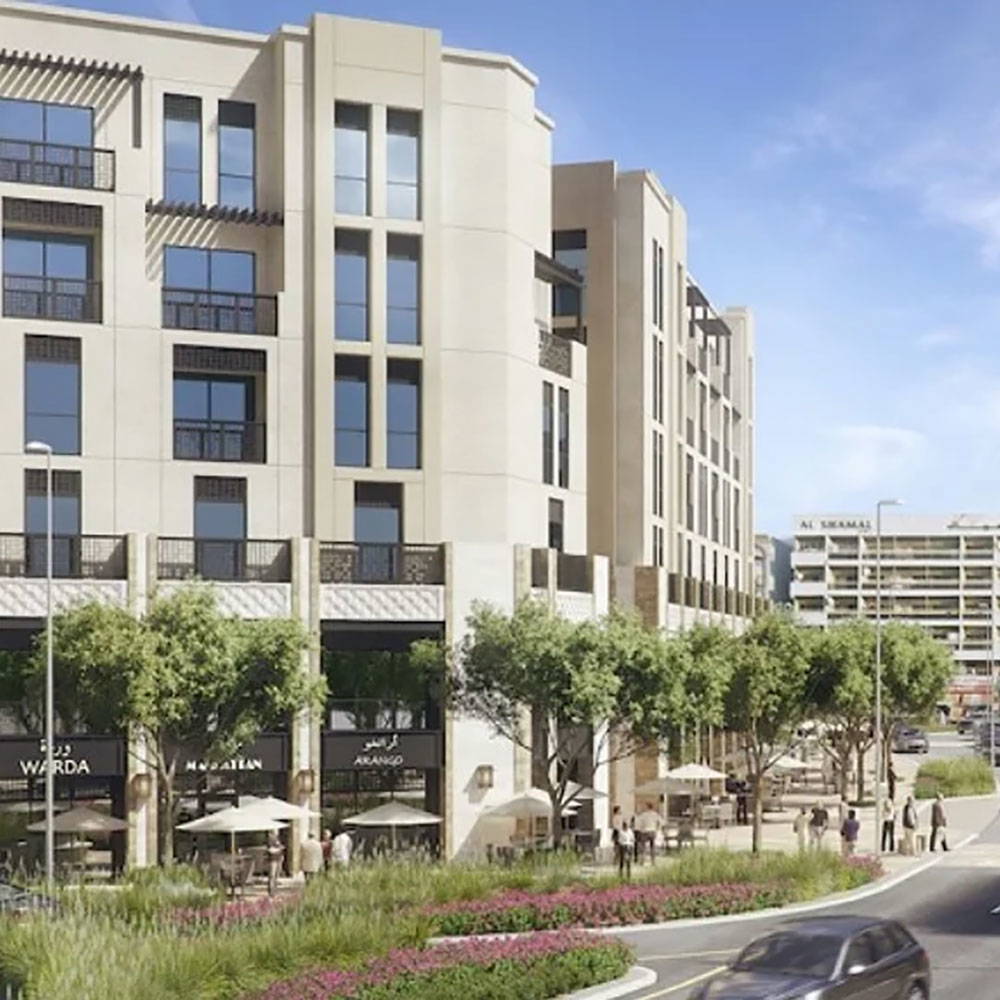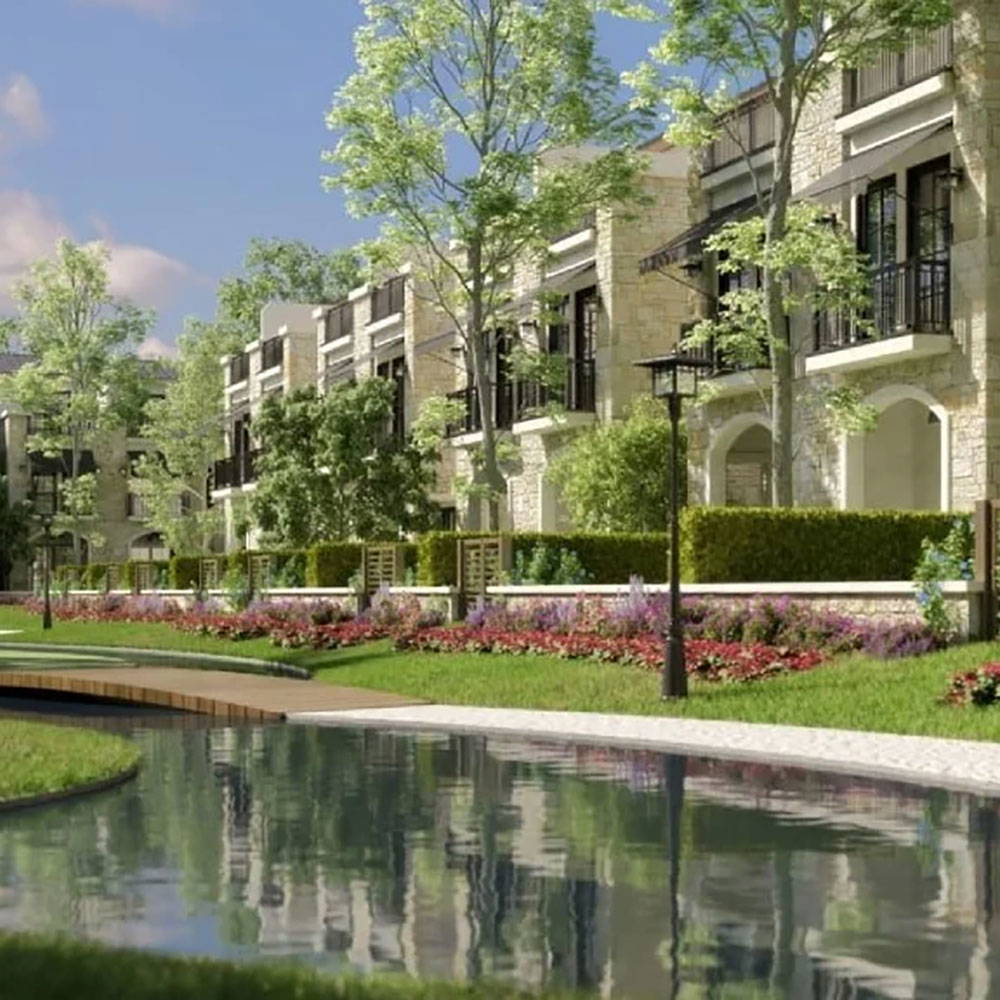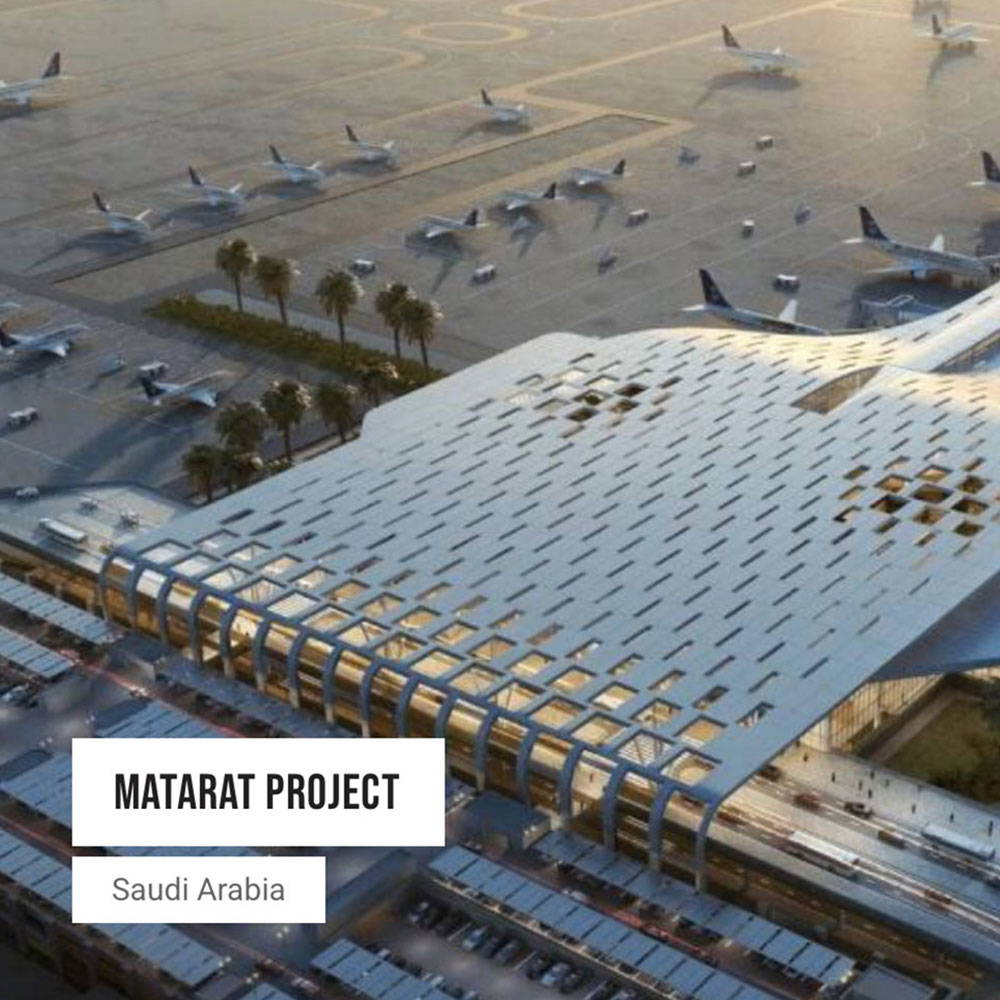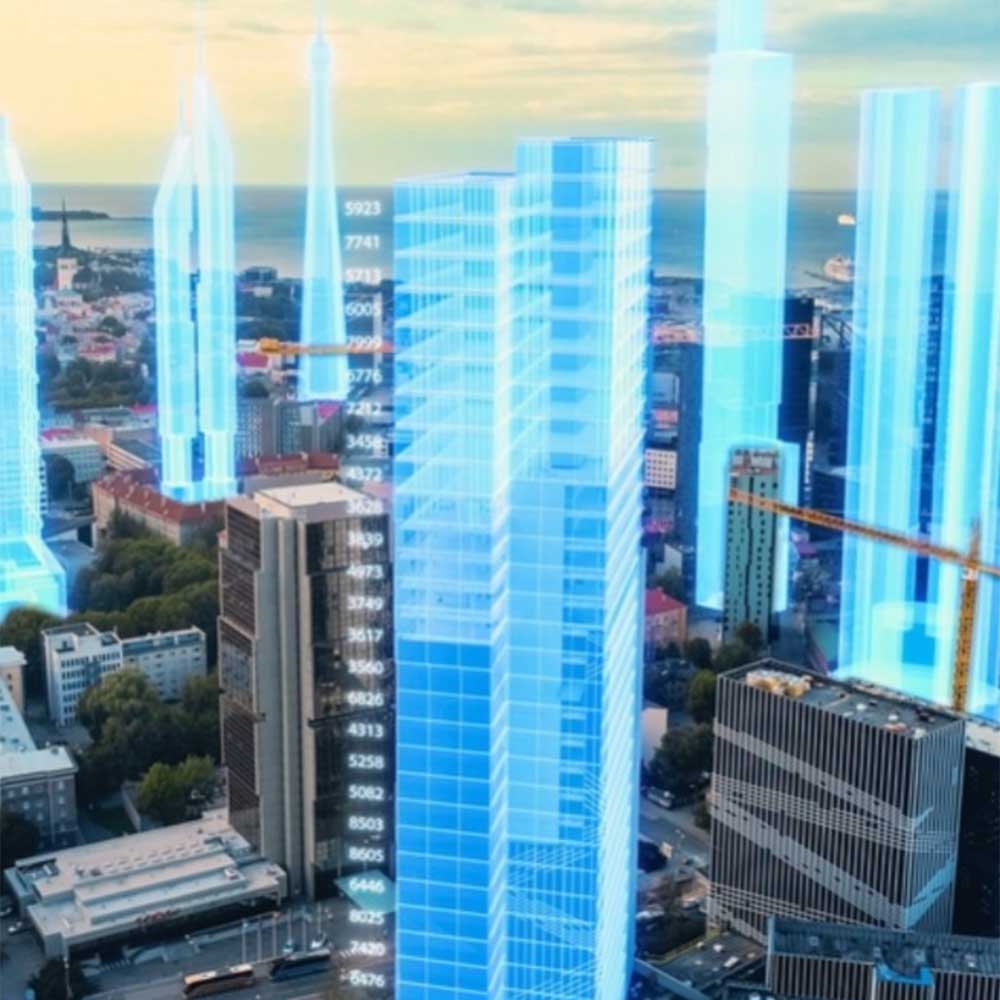INTRODUCTION TO VERTICAL LIVING FAÇADES
Buildings shape the way we experience cities – sometimes for the better, sometimes for the worse. Most structures sit quietly, offering nothing beyond walls and windows. But when a building carries life on its surface, everything changes. The air feels lighter, colours soften the landscape, and what was once a flat façade becomes a place that draws your attention in the best possible way.
This is the essence of our Vertical Living Façades. They are not just green claddings or decorative panels. They are living, breathing ecosystems that become part of the building’s personality. Instead of letting a wall stay passive, we turn it into a vertical environment where plants thrive, microclimates shift, and the building interacts with its surroundings in a meaningful way.
The idea sounds sophisticated, but the experience is simple:
You walk past a living façade, and you immediately sense the difference. The temperature is subtly cooler. The noise feels muted. There’s a softness in the air that concrete and steel could never replicate. You feel calmer, even if it’s just for a moment. The wall becomes a small escape from the pressures of city life.
What makes these façades truly special is the way they integrate technology with nature, without ever feeling “technical” on the surface. Behind the greenery is a carefully designed system – lightweight, hydroponic, and highly efficient – feeding the plants exactly what they need while keeping water use remarkably low. The engineering stays hidden, and what you see is pure, thriving nature.
We create façades that respond to seasons, embrace weather changes, and grow into their environment as time passes. They evolve, filling out in summer, maturing through autumn, staying resilient through winter. Every installation becomes part of the building’s story – shaping how people see it, how they use it, and even how they remember it.
A Vertical Living Façade does more than improve a building; it improves the space around it. It lifts moods, cleans the air, reduces heat, and supports the natural rhythms of the environment. For architects, developers, and planners, it’s not just an aesthetic choice; it’s a contribution to a healthier city.
This is how we bring life back into the built world – one façade at a time.
WHAT MAKES OUR FAÇADES DIFFERENT
There’s no shortage of green wall concepts in the industry, but not all living façades are created with the same level of care, durability, or long-term thinking. Ours are designed to be dependable, resilient, and genuinely beneficial – both for the building and for the people around it.
Here’s what sets our Vertical Living Façades apart:
1. A Hydroponic System That’s Built to Last
Soil is unpredictable. It shifts, compacts, and breaks down, often leading to waterlogging or plant loss. Our façades use a rock-fibre hydroponic substrate that stays stable year after year. It doesn’t rot, doesn’t shrink, and doesn’t release weight onto the structure.
Because the medium is engineered to distribute oxygen, water, and nutrients evenly, plants develop stronger root systems and remain stable – even on steep vertical surfaces.
This leads to:
• significantly lower plant replacement rates
• consistent growth patterns
• healthier long-term vegetation
• and fewer maintenance interventions
2. Designed for Real-World Weather – Not Controlled Conditions
A vertical façade must survive more than just sunlight and water. It faces wind loads, temperature shifts, fluctuating humidity, and outdoor pollutants. Our system adapts to these without breaking down or causing strain on the building.
The panels withstand:
• freezing winters
• peak summer heat
• heavy rainfall
• dry spells
• rapid temperature changes
The growing medium is dimensionally stable, meaning it keeps its shape and density whether it’s fully saturated or completely dry.
3. Intelligent Water Management (Without the Waste)
Water efficiency isn’t an optional feature – it’s built into the heart of the system. Our irrigation delivers moisture precisely where it’s needed, reducing water consumption by up to 90% compared with soil-based designs.
The irrigation backbone includes:
• controlled drip delivery
• moisture-regulated cycles
• efficient drainage channels
• anti-clogging emitters
• automated or semi-automated control setups
Every drop is accounted for, ensuring plants stay healthy without unnecessary waste.
4. Cooling and Energy Benefits You Can Actually Measure
Living façades naturally shield buildings from heat. When sunlight hits a traditional exterior, that heat radiates inward. When sunlight hits a plant surface, the plants absorb it and release moisture – a natural cooling effect known as evapotranspiration.
This can reduce:
• surface temperatures by double digits
• indoor cooling demand in summer
• heating load fluctuations
• urban heat island intensity
Some installations have recorded up to 25% energy savings simply because the façade stabilises the temperature of the building envelope.
5. Air Purification That Happens Quietly, Constantly
Even a modest-sized living façade can make a substantial difference in air quality. Plants absorb CO₂ and trap particulate matter, improving the surrounding environment.
A 200-square-foot wall, for example, can remove hundreds of pounds of CO₂ annually – continuously, without noise, energy, or machinery.
6. Sound Absorption for Noisy Urban Areas
Cities are loud. Traffic, footfall, mechanical systems – noise is part of daily life. The multi-layered structure of a living façade absorbs sound waves, reducing the sharpness of ambient noise.
This is especially effective for:
• busy streets
• office districts
• hospitality venues
• residential blocks near transport corridors
It doesn’t eliminate noise, but it softens it, making the urban environment feel far less overwhelming.
7. A Safer, Longer-Lasting Building Envelope
The façade acts as a protective layer. Plants shield the surface from UV exposure, heavy rain, and temperature swings. Over time, this reduces the fatigue and wear on exterior materials.
The building ages slower, stays cooler, and remains structurally healthier.
8. Built with Future Maintenance in Mind
We never design a façade that becomes a burden. Our systems are modular, accessible, and easy to service. Plants stay healthier, the substrate remains stable, and water delivery stays consistent.
This results in:
• predictable maintenance schedules
• lower running costs
• fewer unexpected failures
• easier plant replacement when needed
The wall keeps performing year after year.
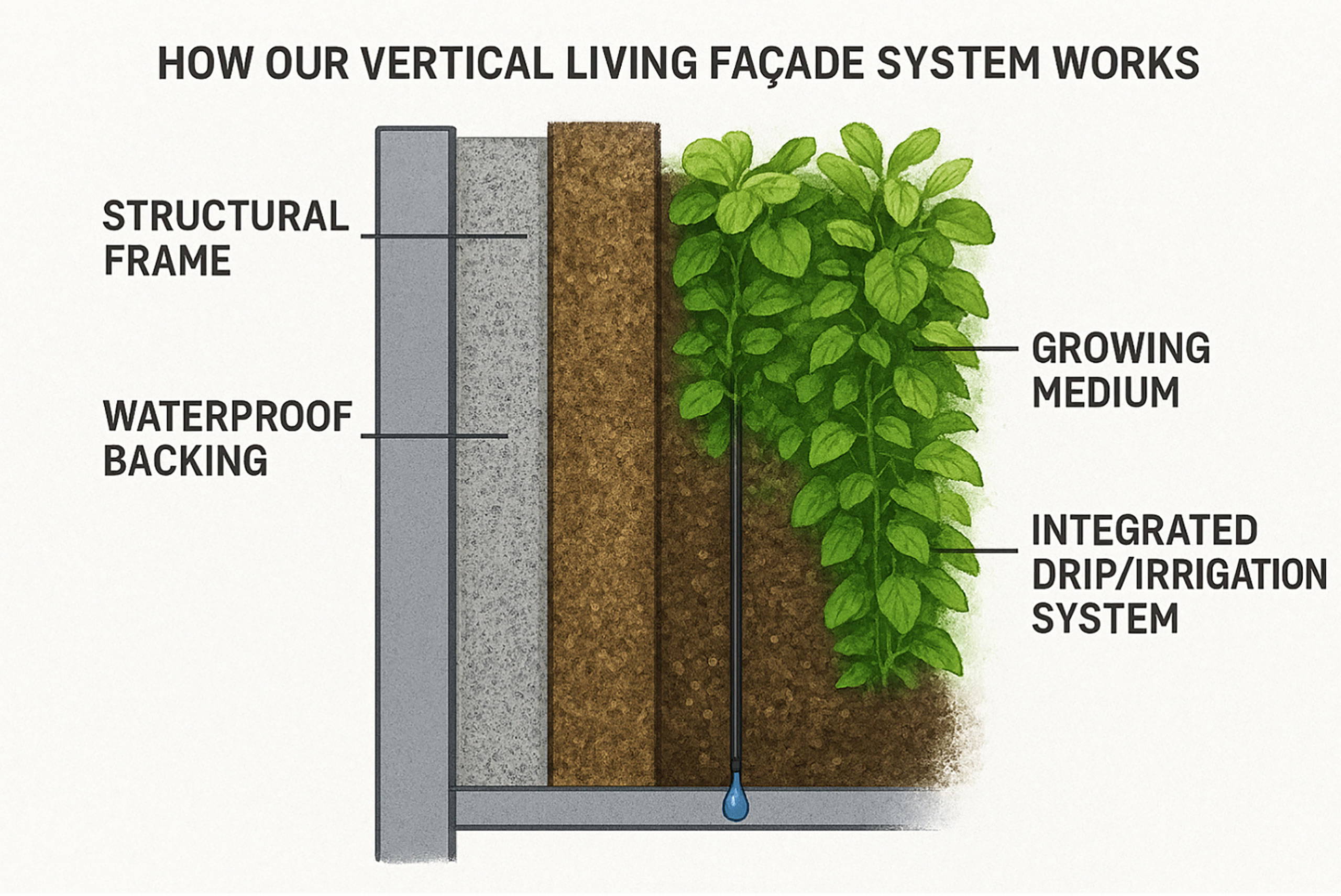
HOW OUR VERTICAL LIVING FAÇADE SYSTEM WORKS
When you look at a vertical living façade, it seems simple: plants, leaves, trailing growth, colours shifting through the seasons. But behind that natural beauty lies a system that has been engineered with precision so that the plants stay healthy, the wall remains stable, and the building is never put under strain.
A living façade works quietly in the background. There’s no heavy machinery, no noisy mechanisms, no complex routines. It’s a balanced relationship between structure, water, nutrients, airflow, and light. We design it so each part supports the other.
1. The Structural Backbone
Everything starts with a lightweight frame that attaches securely to the building without penetrating waterproofing or causing unnecessary load. The frame creates a space between the plants and the building’s surface, allowing air to circulate and moisture to dry properly.
This gap prevents:
• moisture accumulation
• mould or algae
• heat transfer to the building
• unnecessary load on the main structure
It keeps the building safe, dry, and protected, while creating the perfect foundation for a thriving vertical landscape.
2. The Hydroponic Growing Medium
Instead of soil, the wall uses a stable, rock-fibre based medium. It doesn’t crumble, shrink, compact, or rot – which makes it ideal for long-term vertical growing. Plants anchor into the fibres naturally, forming a dense and secure root network.
Why this matters:
• soil becomes heavy and unstable when wet
• soil breaks down over time, rock-fibre doesn’t
• the medium distributes oxygen, water, and nutrients evenly
• roots stay healthier, stronger, and more resilient
This is the heart of the system – the reason our walls stay vibrant year after year.
3. The Water & Nutrient Delivery System
Think of it like giving plants exactly what they need, exactly when they need it. No more, no less.
Our irrigation lines deliver water in controlled cycles, guided by moisture levels and plant requirements. The system prevents overwatering and ensures every drop has a purpose.
The benefits:
• up to 90% less water use
• minimal runoff and waste
• no dry patches
• reduced maintenance needs
• consistent plant health across the entire façade
The plants grow evenly, without the patchiness seen in older green wall systems.
4. Drainage That Works With Gravity, Not Against It
Water that isn’t absorbed moves downward through dedicated channels, eventually collecting in a drain line. This avoids pooling, leakage, staining, or waterlogging.
The drainage system:
• prevents oversaturation
• protects the building
• keeps the root zone oxygen-rich
• maintains stable moisture levels
This drainage design is one of the reasons the façades can withstand extreme weather – from cold nights to scorching afternoons.
5. Airflow & Plant Cooling
Plants naturally release moisture as they grow. The movement of air behind and through the façade helps regulate humidity, prevents stagnation, and allows the plants to stay fresh, even during heatwaves.
This airflow layer contributes to:
• lower building temperatures
• healthier plant respiration
• reduced heat island effects
• better evaporative cooling
It’s a synergy between nature and structure – the plants help the building, and the building helps the plants.
6. Optional Smart Monitoring Systems
For buildings that want a technology-driven edge, sensors can be integrated discreetly.
These sensors help track:
• moisture levels
• temperature
• irrigation cycles
• sunlight exposure
• nutrient delivery
• plant performance
This data helps plan maintenance more efficiently and ensures the wall performs optimally throughout the year.
7. Modularity for Future Changes
Every panel is designed so individual sections can be replaced, refreshed, replanted, or updated without disrupting the entire façade. This keeps long-term care predictable, accessible, and cost-efficient.
This entire system – structural frame, hydroponics, irrigation, drainage, airflow, and optional smart monitoring – works together so the plants can do what they do best: grow, breathe, cool, filter, shade, and beautify.
PLANT DESIGN, BOTANICAL STRATEGY & THE ART OF GROWTH
A living façade is only as beautiful and resilient as the plants you choose to grow on it. That’s why we treat plant selection as both a science and an art. Every project starts with an understanding of its environment – sunlight, orientation, wind exposure, seasonal temperature changes, humidity, and maintenance expectations.
From there, we build a plant palette that doesn’t just survive, but thrives.
1. Understanding the Site First
Before choosing a single leaf, we study:
• whether the wall faces north, south, east, or west
• how much shade or sun it receives
• the local climate patterns
• exposure to wind
• surrounding structures and reflections
• whether it’s indoors or outdoors
• heating vents or nearby pollutants
This ensures the plants are perfectly matched to their environment.
2. Crafting the Plant Palette
We use a wide variety of species including:
• hardy perennials
• small shrubs
• flowering plants
• shade-tolerant greens
• ferns and mosses
• trailing species
• evergreen climbers
• edible herbs (where requested)
• seasonal colour species for dynamic façades
This allows each façade to have a character of its own – whether soft and calming, vibrant and colourful, or lush and forest-like.
3. Texture, Colour & Rhythm
Living façades are compositions. They have depth, movement, and patterns. We design with contrasts in mind:
• fine leaves against broad foliage
• dark greens beside silver hues
• bold seasonal flowers against stable evergreens
• trailing edges beside upright growth
The result is a tapestry-like effect that feels alive, even from a distance.
4. Seasonal Transformation
Our façades are not static. They shift and change throughout the year:
Spring – tender new growth, fresh greens
Summer – fullness, flowering peaks
Autumn – warm tones, structured silhouettes
Winter – evergreen backbone, subtle textures
We plan for this natural rhythm so the wall always looks intentional and cared for.
5. Indoor Planting Schemes
Indoor façades have their own distinct ecosystem. Here we use:
• low-light resilient species
• tropical varieties
• humidity-friendly plants
• slow growers
• air-purifying foliage such as philodendrons, ferns and dracaenas
These create calm, oxygen-rich indoor environments ideal for workplaces, reception areas, and healthcare settings.
6. Long-Term Plant Health
Because of the stable hydroponic medium and controlled irrigation, plants tend to develop stronger root systems compared to soil walls. This leads to:
• improved resilience
• better nutrient absorption
• lower replacement rates
• fuller, more even growth
We’re able to create walls that feel alive, intentional, and carefully curated – never patchy or neglected.
Sustainability, Environmental Contribution & Urban Performance
Sustainability isn’t a slogan for us – it’s the everyday reality of what these living façades actually do once they’re in place. A single wall quietly carries out more environmental work in a year than most people realise. It filters pollutants from the air, traps particulate matter, and gently improves the immediate air quality around the building. Even a relatively compact façade can have a measurable impact, especially in dense urban corridors where green space is limited.
Vertical greenery plays a subtle but powerful role in temperature regulation. Plants naturally cool their surroundings, and when they sit across a building’s external skin, they create a buffer that reduces heat absorption. This helps stabilise internal temperatures, cutting back on air-conditioning demand during warmer months. In cooler months, that same living layer acts as an extra shield, softening wind exposure and supporting better insulation. It’s not a replacement for a building’s mechanical systems, but it does help them work less aggressively, which translates directly into reduced energy consumption over time.
Another overlooked benefit is the way living façades support rainwater behaviour. Many of our systems incorporate water retention design, meaning the plants and growing media temporarily hold rainfall rather than letting it rush immediately into drainage systems. In heavy storms, this helps ease strain on local infrastructure. Over a full year, it contributes to calmer, more balanced water management – a small shift that becomes meaningful when scaled across multiple buildings.
In areas where biodiversity is declining, a vertical façade can offer small but essential stepping-stone habitats. Insects, small pollinators, and occasional birds interact with these installations more than people expect, particularly when plant selections include nectar-rich and seasonal species. This doesn’t turn a building into a nature reserve, but it does create a thread of ecological value running through the city where previously there was none.
From a sustainability reporting standpoint, living façades help organisations meet environmental goals in tangible ways. They contribute to wellbeing metrics, air quality improvement, energy efficiency, and urban greening targets required by many councils and green building frameworks. But more than ticking boxes, they represent a shift in how buildings behave – quieter, cleaner, softer on the environment, and far more connected to the natural world.
Applications Across Sectors
Vertical Living Façades are flexible by design, which is why they work across such a wide range of settings. No two buildings require the same thing, so we shape each solution according to the character and constraints of the space.
Commercial & Corporate Buildings
Office façades often benefit the most because employees respond so strongly to greenery. A quiet, planted exterior softens the familiar glass-and-steel aesthetic and signals a workplace that genuinely values wellbeing. In corporate settings, these walls also serve as visible commitments to environmental responsibility, without needing to say a word
Retail & Hospitality
Hotels, cafés, and retail fronts use living façades to create atmosphere and identity. Plants have a way of slowing people down – they make entrances feel more welcoming and encourage passersby to look twice. For hospitality businesses, greenery naturally encourages people to stay longer, which directly supports footfall and brand perception.
Residential Developments
In multi-unit housing or private estates, vertical greenery adds privacy, breaks up repetitive building lines, and gives residents a visual connection to nature without needing large ground-level gardens. Property value benefits are well documented; homes surrounded by greenery simply feel better to live in.
Public Sector & Community Spaces
Schools, libraries, museums, and healthcare facilities all respond positively to vertical greenery. For learning environments, it provides a calmer backdrop that improves focus. In healthcare, it can contribute to reduced stress and a more soothing environment for patients and staff. Public landscape projects often use living façades to reintegrate nature into dense neighbourhoods.
Transport & Infrastructure
Car parks, underpasses, station environments, and highway-adjacent buildings can use living walls to manage heat, absorb sound, and soften the feel of hard infrastructure. These installations are functional but also vital for improving the experience of spaces that people typically pass through quickly and without comfort.
Industrial & Utility Structures
Even structures rarely considered “architectural,” such as data centres or service buildings, can benefit from a green envelope that reduces visual impact and improves energy performance. These aren’t decorative additions – they help functional buildings blend responsibly into their surroundings.
Across all sectors, the constant theme remains the same: people respond instinctively to plant life, and buildings benefit from the quiet functional performance these systems provide.
Maintenance Philosophy & Long-Term Care
Living façades only thrive when they’re treated as the living systems they are. Our maintenance philosophy is built around gentle, steady monitoring rather than heavy intervention. Plants, like people, do best when they’re given consistent, thoughtful care – not rushed fixes or reactive attention.
Each façade has its own rhythm. Sun exposure, wind patterns, plant species, and irrigation behaviour all influence how it evolves. Instead of applying a generic maintenance schedule, we tailor our visits and checks to the wall’s specific environment. Some façades want more frequent light trimming, others prefer to grow into a fuller, looser form. Our team observes how the plants respond through the seasons and adapts the care plan accordingly.
Irrigation is monitored closely, but discreetly. Modern systems allow for precise water delivery, and most adjustments can be made without disturbing the building. We keep a close eye on moisture levels, nutrient flow, and plant root health. Over-watering and under-watering are equally harmful, so our aim is balance – enough hydration to keep the plants vigorous, but not so much that they rely on constant input.
A major part of long-term success is anticipating changes rather than reacting to them. Plants grow, mature, and sometimes shift in character as they age. Instead of seeing this as a problem, we view it as the natural life of the façade. When certain species begin to overshadow others, we guide the growth back into harmony or introduce supportive replacements. This keeps the wall feeling alive in the truest sense – not frozen in time, but evolving gracefully.
Seasonal refreshes are part of the journey. Some plants thrive year-round; others shine in specific seasons and rest during others. If certain areas need strengthening or reseeding, we handle it with sensitivity so the wall maintains its continuity.
Our long-term clients appreciate that maintenance is not an afterthought – it’s an essential part of the craft. The aim is always to keep the façade healthy, stable, and looking effortless, even though there is skilled horticultural work happening quietly behind the scenes.
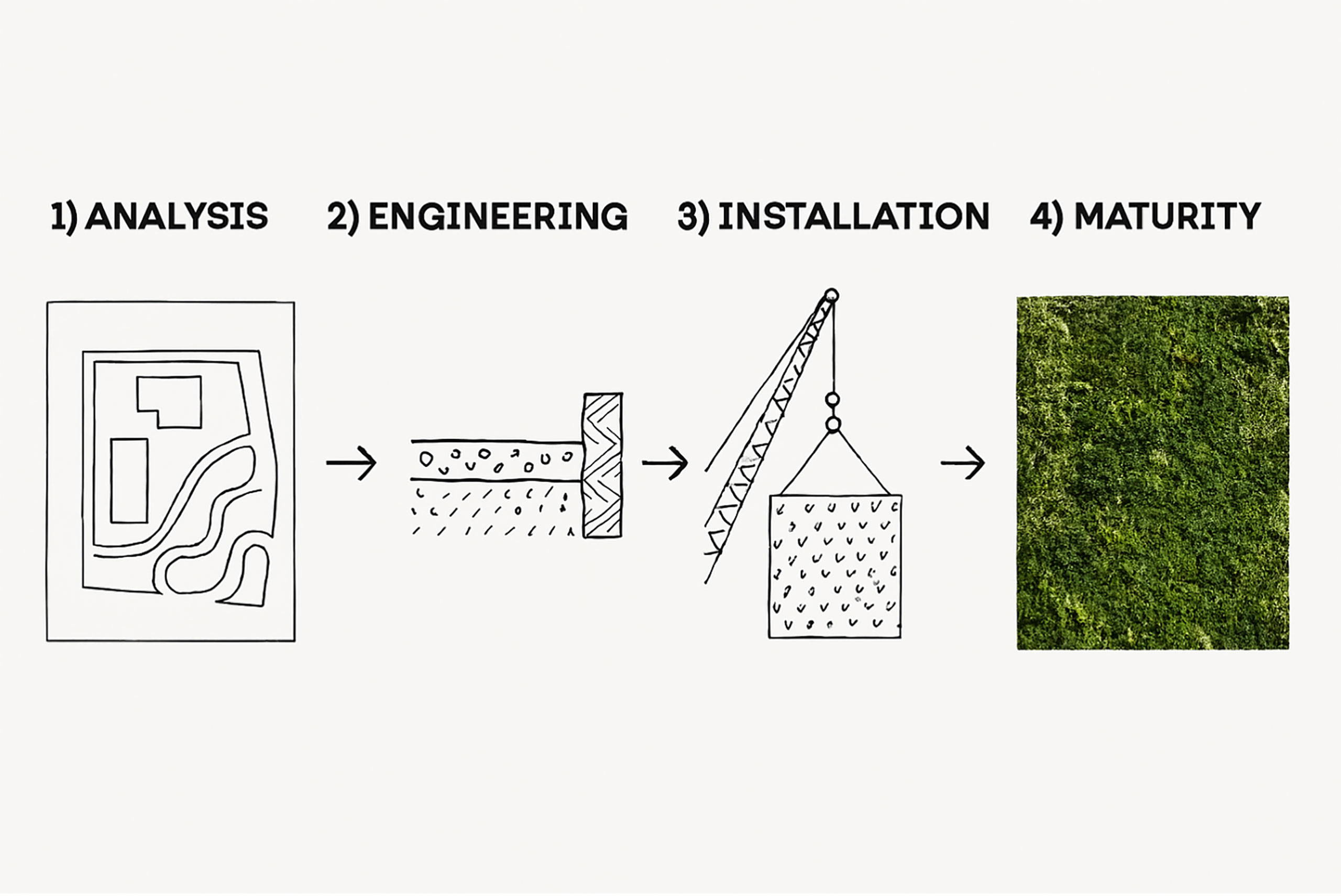
The Design, Engineering & Delivery Process
Every Vertical Living Façade begins with a conversation. Before sketches, calculations, or plant lists, we spend time understanding what the building needs – visually, structurally, and environmentally. Some clients come with clear ideas; others simply want something natural and calming. Either way, the first step is to listen.
Once we understand the intent, we move into the technical side. Our design team studies the building’s orientation, load-bearing capacity, exposure to wind and sun, access points, and the existing façade material. This helps us determine which system platform will perform best and which planting style will thrive long-term. We balance practicality with creativity, making sure the result is as reliable as it is visually engaging.
The engineering phase deals with the finer details: irrigation routes, panel configurations, weight distribution, structural fixings, drainage behaviour, and long-term plant performance. It’s a collaborative stage where architects, engineers, and our horticultural specialists work together to make sure the installation is robust without appearing overly engineered.
Once the system is finalised, we prepare the planting design. This is where the façade begins to develop its personality. We choose species based on climate, orientation, maintenance expectations, and visual character. We consider seasonal variation, growth habits, texture, and longevity. The goal isn’t to create a short-lived display, but a living palette that matures beautifully over time.
Installation is carried out with precision and respect for the site. We coordinate with contractors and facility teams to avoid disruption, ensuring the wall is fitted securely and safely. Irrigation is tested, drainage is balanced, and each plant is placed intentionally, not just inserted.
After installation, the façade is never left to fend for itself. We monitor its behaviour closely in the first months to make sure it settles in well. Any early adjustments are made promptly so the plants establish strong root systems and adapt comfortably to their new vertical home.
By the time the façade reaches its first full season, it usually begins to express its true character – greener, fuller, and more integrated with the building. From there, regular care keeps it balanced, healthy, and evolving exactly as intended.
Vertical Living Façades – Full Scope of Services
At Façade Creations, our Vertical Living Walls are designed to do more than look beautiful – they deliver tangible environmental, social, and architectural benefits. We provide a full-service solution covering the design, engineering, installation, and ongoing care of your living façade.
Our scope includes:
- Consultation & site analysis to understand light, wind, temperature, and orientation
- Structural feasibility assessments and frame design
- Custom hydroponic substrate selection and plant palette design
- Water delivery and nutrient management systems
- Modular panels for easy access and maintenance
- Optional smart monitoring systems for plant health and irrigation tracking
- Seasonal refresh programs to maintain aesthetic and functional performance
Every project is tailored to meet the building’s requirements, climate, intended use, and long-term maintenance plan.
Vertical Edible Gardens / Food-Producing Green Walls
Beyond decorative greenery, we design vertical edible gardens that transform unused walls into productive, food-growing surfaces. Perfect for homes, commercial kitchens, rooftop cafés, community spaces, and wellness-focused environments, these walls grow herbs, leafy greens, and small vegetables while maintaining a clean and professional appearance.
Key features include:
- Hydroponic or soil-less systems designed for urban settings
- Plant selections for culinary or seasonal produce (e.g., basil, mint, parsley, kale, cherry tomatoes, microgreens)
- Controlled irrigation and nutrient delivery
- Easy access for harvesting and maintenance
- Options for organic, pesticide-free setups
Applications:
- Home balconies or kitchen walls
- Restaurants & cafés
- Schools & community programs teaching sustainable growing
- Rooftops & courtyards
- Wellness brands and eco-conscious businesses

Vertical Fruit Gardens / Fruit-Bearing Living Walls
Taking edible greenery a step further, our Vertical Fruit Gardens introduce compact, small-fruit varieties designed specifically for controlled vertical growth. These systems bring seasonal freshness directly to façades, balconies, courtyards, and outdoor hospitality spaces – allowing buildings to grow real, harvestable fruit without compromising on aesthetics or structural integrity.
These fruit-bearing walls are engineered with enhanced support, smart irrigation, and climate-appropriate plant selections. Whether it’s strawberries cascading from panels or miniature citrus adding bursts of color and fragrance, every installation is crafted to produce reliably while remaining visually refined.
Key Features Include:
• Specially selected dwarf and compact fruiting varieties
• Hydroponic or substrate-based growing systems optimized for fruit yield
• Reinforced panel design to support heavier, fruit-bearing plants
• Automated nutrient feed tailored to fruiting cycles
• Seasonal pollination strategies for outdoor installations
• Clean, pest-managed setups suitable for hospitality and residential use

Typical Fruit Options:
• Strawberries (high-yield and ideal for vertical growth)
• Dwarf citrus (lime, lemon, calamondin – depending on climate)
• Blueberries (compact varieties for vertical beds)
• Dwarf figs (lightweight varieties for façades with stronger exposure)
• Passionfruit (climbing, aromatic, visually stunning)
• Grapes (select species for strong sunlight façades)
• Seasonal berries (raspberries, blackberries, depending on region)
Applications:
• Residential balconies & private gardens
• Rooftops and terraces
• Restaurants, cafés & farm-to-table concepts
• Hospitality courtyards and poolside areas
• Community wellness programs
• Educational gardens for schools
• Health-focused brands promoting fresh, hyper-local produce
Why Vertical Fruit Gardens Matter:
Fruit-bearing façades combine beauty with genuine nutritional value. They soften building lines, create natural shade, and deliver small but consistent seasonal harvests – all while functioning as living architecture. They are ideal for clients who want greenery that gives something back, turning unused vertical space into productive, sensory-rich environments.
Add-On Enhancements & Optional Upgrades
For clients seeking premium experiences, optional enhancements include:
- Uplighting & architectural lighting to highlight textures at night
- Integrated water meters for sustainability reporting
- Moisture sensors and app-connected irrigation
- Aromatic plant kits (lavender, rosemary, jasmine)
- Sound-absorption backing panels for interior walls
- Built-in planter seating, shelving, or branding elements
- Seasonal plant rotation programs
These add-ons allow clients to personalize their living façade beyond the standard system.
Construction & Installation Responsibilities
Our team ensures every living wall is built to last with precision:
- Coordination with contractors and site teams
- Installation of structural frames and fixings
- Waterproofing and root barrier application
- Irrigation line installation, filtration, and testing
- Drainage channel setup
- Precise plant placement and initial establishment
- Commissioning and performance checks before handover
Every wall undergoes a full inspection to ensure safety, plant health, and system performance.
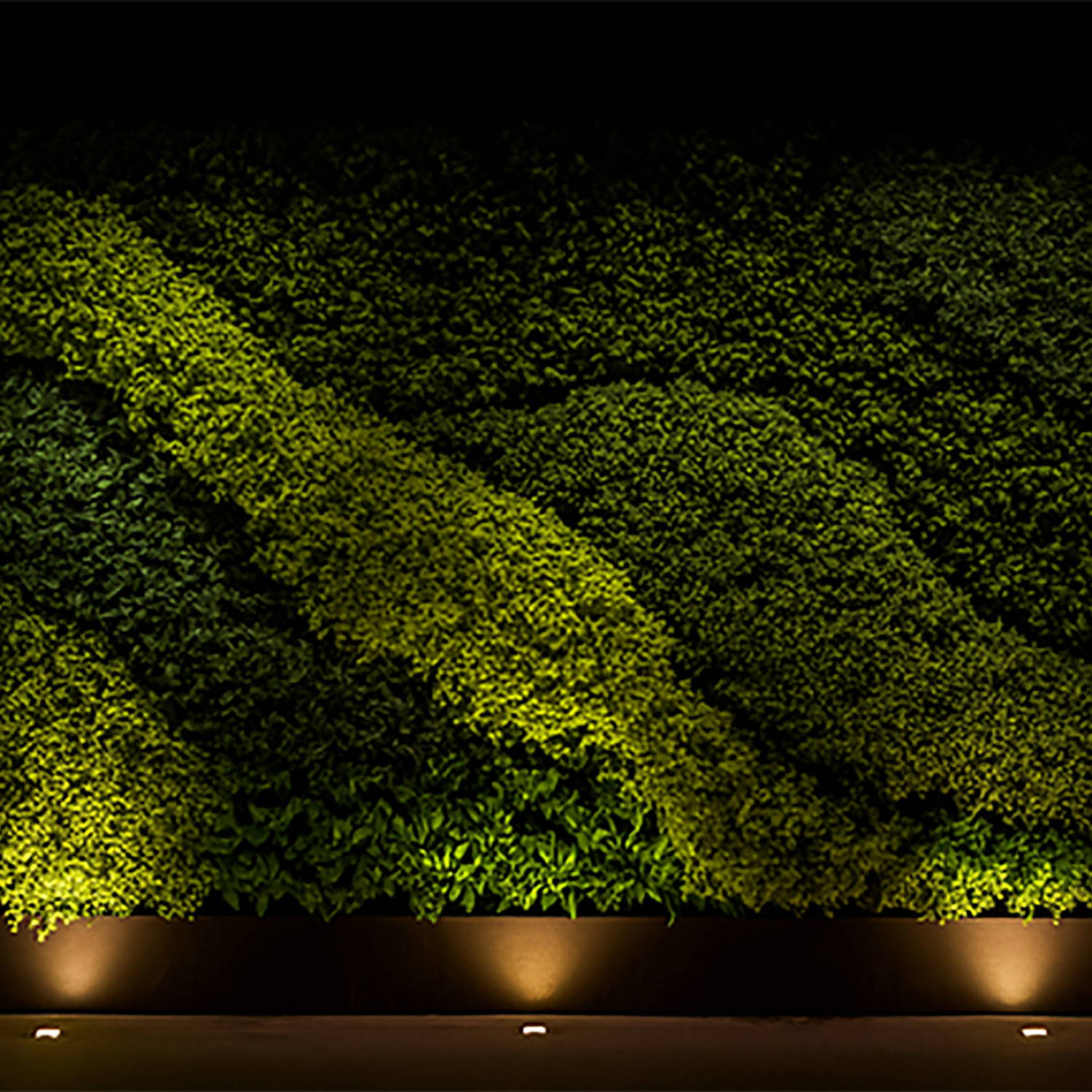
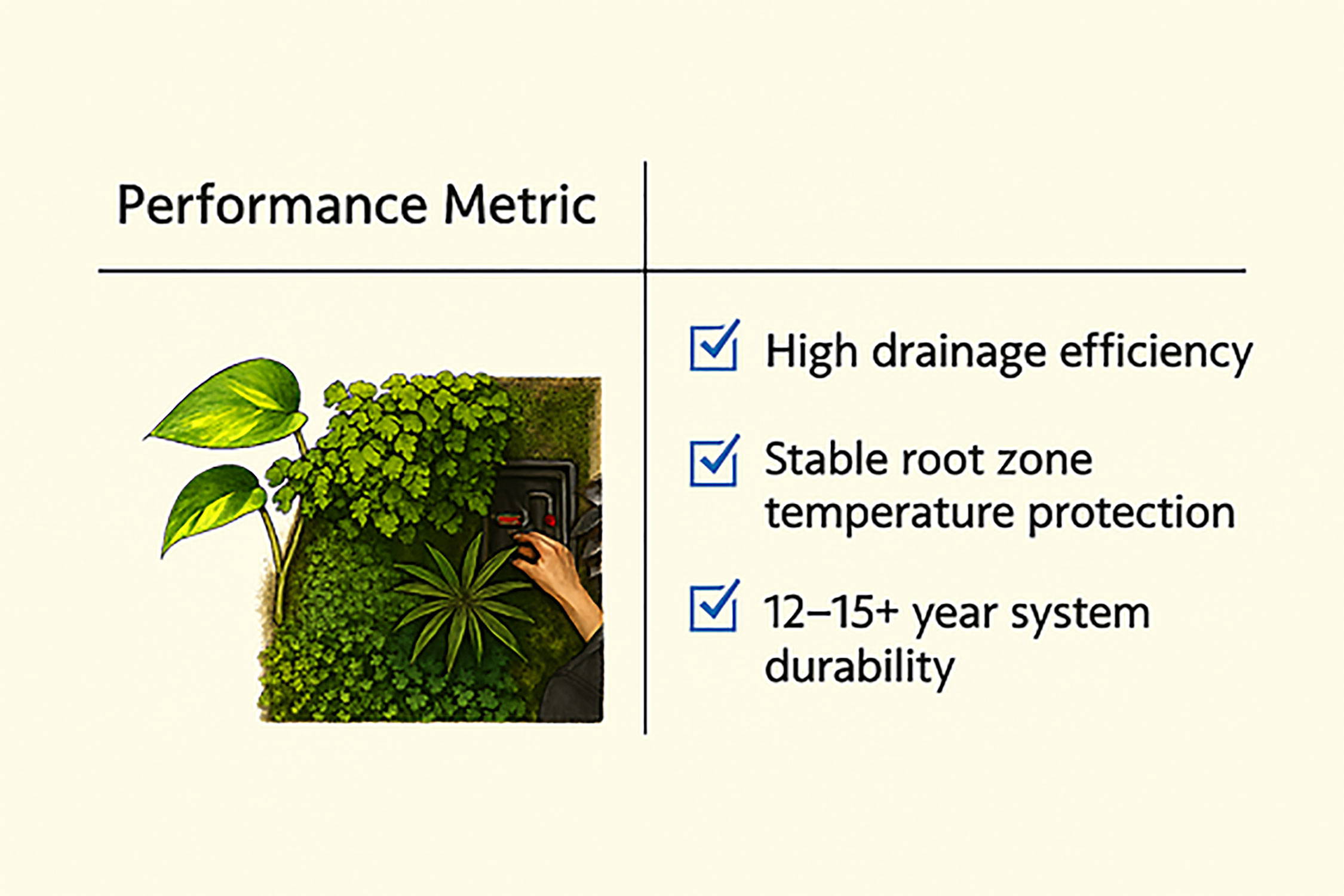
Technical Performance Expectations
Vertical Living Walls are engineered for consistent, long-term performance:
- Even irrigation across all modules
- High drainage efficiency to prevent waterlogging
- Stable root zone temperature protection
- UV and weather-resistant materials
- Fire-retardant panel options
- Modular accessibility for maintenance
- 12-15+ year system durability with proper care
These specifications ensure your façade functions optimally year-round.
Compliance, Standards & Certifications
Our systems are designed to comply with:
- Fire safety standards for façades
- Local building regulations
- Water management and backflow compliance
- Electrical safety standards for automated irrigation
- Environmental responsibility and sustainable plant sourcing
- Non-toxic, low-VOC materials
Where required, we coordinate with inspectors and consultants for full compliance documentation.
Client Responsibilities
To ensure optimal wall performance, clients are expected to:
- Maintain water and power supply to the system
- Avoid interfering with plant growth or trimming
- Keep irrigation lines clear and unobstructed
- Report unusual plant conditions promptly
- Allow scheduled maintenance access
- Follow recommended cleaning and maintenance protocols
FAQs
Q1: How much maintenance is required for a living wall?
A: With proper irrigation and seasonal care, most walls require 1-2 routine visits per month, plus seasonal plant refreshes.
Q2: Can vertical edible walls produce meaningful yields?
A: Yes. Even a compact hydroponic wall can supply fresh herbs and greens year-round when designed correctly.
Q3: Are these walls suitable for indoor environments?
A: Absolutely. Indoor walls are designed with low-light and humidity-tolerant species to thrive inside offices, homes, or public spaces.
Q4: What happens during extreme weather?
A: Our walls are engineered to handle temperature fluctuations, wind, and heavy rain without compromising plant or structural health.
Q5: How long do the systems last?
A: With proper maintenance, frames, irrigation systems, and plants can perform for 12-15+ years.
Transform your space with living architecture that truly makes a difference.
Request a Consultation
